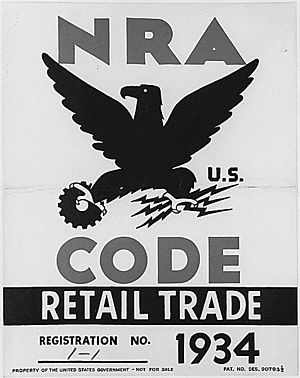National Recovery Administration

As part of the New Deal in the United States, the National Recovery Administration (created by the National Industrial Recovery Act) was developed by President Franklin D. Roosevelt and his administration. It allowed industries to create "codes of fair competition," which were intended to reduce destructive competition and to help workers by setting minimum wages and maximum weekly hours. Most economic historians consider the NRA to be a resounding failure with very little positive economic success.
The NRA, symbolized by the blue eagle was popular with workers. Businesses that supported the NRA put the symbol in their shop windows and on their packages. Though membership to the NRA was voluntary, businesses that did not display the eagle were urged to be boycotted - making it seem mandatory for survival.
Its director was Hugh S. Johnson, a retired general and successful businessman. Johnson saw the NRA as a national crusade designed to restore employment and regenerate industry. Johnson was removed in 1934, In early 1935 the new chairman announced that the NRA would stop setting prices, but businessmen complained. Chairman Samuel Williams told them plainly that, unless they could prove it would damage business, NRA was going to put an end to price control. Williams said, "Greater productivity and employment would result if greater price flexibility were attained." Of the 2,000 businessmen on hand probably 90% opposed Mr. Williams' aim, reported Time magazine. "To them a guaranteed price for their products looks like a royal road to profits. A fixed price above cost has proved a lifesaver to more than one inefficient producer." The business position was summarized by George A. Sloan, head of the Cotton Textile Code Authority:
| “ | "Maximum hours and minimum wage provisions, useful and necessary as they are in themselves, do not prevent price demoralization. While putting the units of an industry on a fair competitive level in so far as labor costs are concerned, they do not prevent destructive price cutting in the sale of commodities produced, any more than a fixed price of material or other element of cost would prevent it. Destructive competition at the expense of employes is lessened, but it is left in full swing against the employer himself and the economic soundness of his enterprise....But if the partnership of industry with Government which was invoked by the President were terminated (as we believe it will not be), then the spirit of cooperation, which is one of the best fruits of the NRA equipment, could not survive.[1] | ” |
About 23,000,000 people worked under the NRA fair code. However, violations of codes became common and attempts were made to use the courts to enforce the NRA. The NRA included a multitude of regulations imposing the pricing and production standards for all sorts of goods and services. Individuals were arrested for not complying with these codes. For example, a man named Jack Magid was jailed for violating the "Tailor's Code" by pressing a suit for 35 rather than NRA required 40 cents. John T. Flynn, in The Roosevelt Myth (1944) reported:
| “ | The NRA was discovering it could not enforce its rules. Black markets grew up. Only the most violent police methods could procure enforcement. In Sidney Hillman’s garment industry the code authority employed enforcement police. They roamed through the garment district like storm troopers. They could enter a man’s factory, send him out, line up his employees, subject them to minute interrogation, take over his books on the instant. Night work was forbidden. Flying squadrons of these private coat-and-suit police went through the district at night, battering down doors with axes looking for men who were committing the crime of sewing together a pair of pants at night. But without these harsh methods many code authorities said there could be no compliance because the public was not back of it. | ” |
In 1935, in the court case of Schecter Poultry Corp. v. US, the Supreme Court declared the NRA as unconstitutional because it gave the President too much power.[2] The NRA quickly stopped operations, but many of the labor provisions reappeared in the Wagner Act of 1935.
- ↑ "Dollar Men & Prices" Time (Jan 21, 1935) online
- ↑ The Supreme Court Historical Society.
External links
- 1933 Promotional Video for National Recovery Administration
- Article on the NRA from EH.NET's Encyclopedia
- When the Supreme Court Stopped Economic Fascism in America by Richard Ebeling
References
- Best; Gary Dean. Pride, Prejudice, and Politics: Roosevelt Versus Recovery, 1933-1938. Praeger Publishers. 1991
- Hawley, Ellis W. The New Deal and the Problem of Monopoly Princeton UP (1968)
- Johnson; Hugh S. The Blue Eagle, from Egg to Earth 1935, memoir by NRA director
- Lyon, Leverett S., Paul T. Homan, Lewis L. Lorwin, George Terborgh, Charles L. Dearing, Leon Marshall C.; The National Recovery Administration: An Analysis and Appraisal The Brookings Institution, 1935 .
- Ohl, John Kennedy. Hugh S. Johnson and the New Deal (1985), academic biography.
- Schlesinger, Arthur Meier. The Coming of the New Deal (1958) pp 87-176 online version